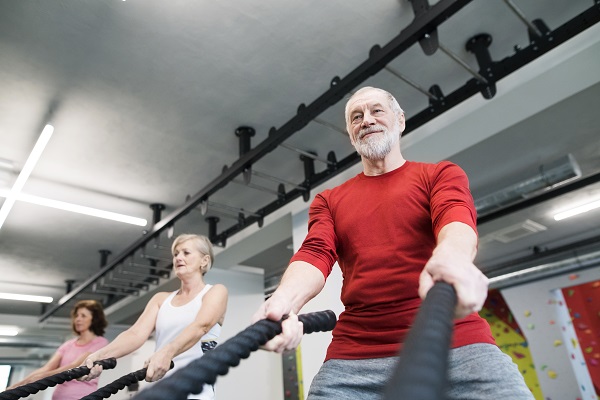If you’re like most people, you probably didn’t expect to be working out in your 60s. But now that you are finding ways to make it work for you is essential. Because as you know, exercise is crucial to staying healthy as you age. So whether you’re just starting or have been exercising for years, read on for some helpful advice! This article discusses different tips for working out in your 60s. It will cover everything from how often to work out to what types of exercises are best for seniors. As you age, your body changes in a lot of ways. You might not be as strong or fast as you once were, and you might start to notice some aches and pains that weren’t there before. It’s important to stay active and exercise as you age because it can help offset some of the effects of aging. Exercise can help to improve your balance and coordination, which can help prevent falls. It can also help strengthen your muscles and bones and increase your flexibility. Furthermore, exercise can help to boost mood and mental health, and it can help to reduce the risk of chronic diseases such as heart disease, stroke, and diabetes. So even though it might be tempting to slow down as you age, staying active is essential for maintaining your health and well-being.
Contents
Tips For Working Out In Your 60’s
If you are in your 60s, the most challenging part about working out is getting started, so if you are reading this, congratulations! You have already taken the first step. It is time to learn some of the best tips for working out in your 60s. Here are a few to get you started:
Take Things Slow
No matter how old you are, it’s never too late to start working out. However, if you’re over 60, you may want to take things a bit slow at first because, as you age, your body becomes less able to handle the impact of high-intensity exercise. In fact, according to a recent study, older adults who begin working out at a moderate pace are just as likely to see health benefits as those who start with a more intense routine. So, if you’re looking to start working out in your 60s, don’t be afraid to take things slowly at first. Your body will thank you for it in the long run.
Choose Exercises You Love
It’s never too late to start working out! In fact, according to the Centers for Disease Control and Prevention (CDC), people in their 60s should still be getting at least 150 minutes of moderate aerobic activity or 75 minutes of vigorous aerobic activity each week. But how do you get started? The key is to find exercises that you enjoy, and that fit your current fitness level. If you’re just starting, you may want to try some low-impact activities like walking, swimming, or Tai Chi. These exercises are easy on the joints and can help you increase your heart rate without putting too much strain on your body. As you get more fit, you can add other exercises like biking, jogging, or even hiking. And don’t forget strength training! Building muscle will help you stay strong and independent as you age. The best way to find exercises that you love is to experiment. Try out different activities and see what feels good for your body. You may be surprised at how much you enjoy a specific exercise that you thought was too difficult or boring. And remember, it’s never too late to start working out!
Ask Your Doctor About Your Routine
It becomes increasingly important for older adults to pay attention to their physical health, especially if they want to stay active and independent as you age. However, it is essential to understand that your body changes as you age, and what may have been safe and effective in your younger years could be harmful now. That’s why it’s always a good idea to check with your doctor before starting or changing your workout routine. They can offer specific advice based on your individual health needs and fitness level. For example, they may recommend that you focus on low-impact activities, start slowly and build up gradually, or add strength training to your routine. So if you’re feeling motivated to get moving in your 60s, don’t forget to give your doctor a call first!
Don’t Forget To Drink Plenty Of Water
Drinking water when working out at any age is essential, but it becomes even more crucial as you get older. As someone in your 60s, your body becomes less efficient at regulating temperature, which means you are more prone to dehydration. Furthermore, your body contains less water, and your cardiovascular system isn’t as effective at moving blood to your muscles. That’s why it’s essential to drink plenty of water before, during, and after exercise, especially if you’re over 60. Make sure to carry a water bottle with you when you work out, and take frequent sips throughout your session. And if you start to feel thirsty, that’s a sign that you’re already dehydrated, so it’s essential to stop and rehydrate immediately. Taking these precautions can help ensure that you stay healthy and hydrated.
Don’t Push Yourself
It is okay that older people need to take things a little easier, especially when it comes to physical activity. Your body cannot handle the stress of strenuous exercise as it once was, and recovery times are longer. However, this does not mean we should give up on physical activity altogether. Moderate exercise can help offset some of the natural declines that occur with age. It can improve our cardiovascular health, help maintain muscle mass, and even boost our mood and cognitive function. So, if you’re in your 60s and looking to start or continue an exercise program, remember to listen to your body and not push yourself too hard. Taking it easy doesn’t mean you can’t still get a great workout.
Follow These Tips For Working Out In Your 60s
Working out in your 60s can be a great way to stay active and independent as you age. However, it’s essential to understand that your body changes as you get older, and what may have been safe and effective in your younger years could be harmful now. That’s why it’s always a good idea to monitor your activity, not push yourself too hard, and check with your doctor before starting or making any changes to your workout routine. They can offer specific advice based on your individual health needs and fitness level.







